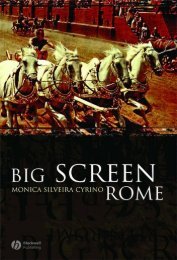Troy From Homer's Iliad to Hollywood Epic - Amazon Web Services
Troy From Homer's Iliad to Hollywood Epic - Amazon Web Services
Troy From Homer's Iliad to Hollywood Epic - Amazon Web Services
You also want an ePaper? Increase the reach of your titles
YUMPU automatically turns print PDFs into web optimized ePapers that Google loves.
12 Martin M. Winkler<br />
a mythic life of their own . . . That is why there is no necessary correspondence<br />
between the excellence of a novel and the quality of the film<br />
in which the novel is recorded . . . the filmist becomes not a transla<strong>to</strong>r for<br />
an established author, but a new author in his own right.<br />
In this description, we should understand “epic” alongside “novel,” as<br />
Blues<strong>to</strong>ne’s reference <strong>to</strong> legendary characters and myth reveals, if rather<br />
unintentionally. The same is true for his conclusion:<br />
Like two intersecting lines, novel and film meet at a point, then diverge.<br />
At the intersection, the book and shooting-script are almost indistinguishable.<br />
But where the lines diverge, they not only resist conversion; they<br />
also lose any resemblance <strong>to</strong> each other. At the farthest remove, novel<br />
and film, like all exemplary art, have, within the conventions that make<br />
them comprehensible <strong>to</strong> a given audience, made maximum use of their<br />
materials. At this remove, what is particularly filmic and what is particularly<br />
novelistic cannot be converted without destroying an integral part<br />
of each . . . the filmed novel, in spite of certain resemblances, will inevitably<br />
become a different artistic entity from the novel on which it is based. 29<br />
The his<strong>to</strong>ry of cinematic translations from texts <strong>to</strong> images parallels, at<br />
least in its wide variety and fluctuations, the his<strong>to</strong>ry of classical myth<br />
within and since antiquity. As Benioff observed, Homer was not the<br />
inven<strong>to</strong>r of the characters or the plots of his <strong>Iliad</strong> and Odyssey, and we<br />
should keep the flexibility of myth in mind when we view or judge a<br />
film like Petersen’s. The subject is <strong>to</strong>o vast <strong>to</strong> be dealt with here, but one<br />
classical scholar’s voice may be adduced as representative. In a chapter<br />
on the limitations of the structuralist approach <strong>to</strong> myth, G. S. Kirk comments<br />
on the variety of mythical s<strong>to</strong>rytelling in antiquity. His words<br />
29 Quoted from George Blues<strong>to</strong>ne, Novels in<strong>to</strong> Film (1957; rpt. Berkeley: University of<br />
California Press, 1961), 62–64 (in a chapter entitled “The Limits of the Novel and the<br />
Limits of the Film”). The literature on adaptation has become extensive since this book<br />
was published. Representative works are André Bazin, “Adaptation, or the Cinema as<br />
Digest,” tr. Alain Piette and Bert Cardullo, in Bazin at Work: Major Essays and Reviews from<br />
the Forties and Fifties, ed. Bert Cardullo (New York: Routledge, 1997), 41–51, rpt. in Film<br />
Adaptation, ed. James Naremore (New Brunswick: Rutgers University Press, 2000), 19–<br />
27; Neil Sinyard, Filming Literature: The Art of Screen Adaptation (New York: St. Martin’s,<br />
1986); Brian McFarlane, Novel <strong>to</strong> Film: An Introduction <strong>to</strong> the Theory of Adaptation (Oxford:<br />
Clarendon Press, 1996); Robert Stam, “Beyond Fidelity: The Dialogics of Adaptation,” in<br />
Film Adaptation, 54–76, and “Novel and Film: The Theory and Practice of Adaptation,”<br />
in La decima musa: il cinema e le altre arte/The Tenth Muse: Cinema and the Other Arts,<br />
ed. Leonardo Quaresima and Laura Vichi (Udine: Forum, 2001), 441–457.



